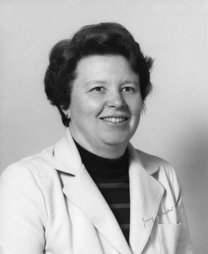Oral history interview with Emma R. Parmee
- 2012-Jan-30 – 2012-Jan-31

Emma Parmee grew up in Keynsham, England, the youngest of four children. Her father was a banker, her mother a housewife. She had always liked math and science, but she also liked languages. She attended all-girls schools, and, beginning to like chemistry in high school, she entered Exeter College at the University of Oxford. The system was rigorous and structured; Eric Thomas was her organic chemistry tutor and became her advisor for her PhD. Parmee’s publication on milbemycin E was awarded the prize for best dissertation in that year.
From Oxford Parmee went to a postdoctoral position in Satoru Masamune’s lab at Massachusetts Institute of Technology (MIT); there she grew more interested in synthesis than in process. After a year in that lab she began her job hunt. She was recruited by Merck & Co. to work in Rahway, New Jersey, on Ann Weber’s medicinal chemistry team. Parmee worked on obesity projects, helping develop L507. She met her husband at Merck and made the decision to stay in the United States. She describes the process of discovery and development of a compound, and explains the evolution of the corresponding work teams. Moving more into team leadership and management, she ran a group of six while also working on smaller projects. She is credited with being instrumental in the discovery of sitagliptin, trademarked JANUVIA, which is used to treat diabetes.
Parmee was able to continue her regular work while helping oversee and organize the merger with Schering-Plough and was named Executive Director, Discovery Chemistry Site Head. This necessitated moving the whole family to West Point, Pennsylvania. She maintains that balancing family life with her extraordinary career has been possible only because her husband shares family duties and because Merck is so flexible. After the move to Pennsylvania Parmee switched fields from metabolic and cardiovascular disorders to neuroscience and infectious disease.
Parmee discusses globalization and Merck’s various sites. She praises Merck’s emphasis on teamwork and collaboration. She talks about her views of science education and the public’s skewed perceptions of drug companies. She says women are still underrepresented in upper levels of management in drug companies but that things are improving. No longer at the bench, she takes her satisfaction in teaching and helping others. She is proud of her three compounds that went to proof of concept in man: β3-agonist, glucagon, DPP-4 (sitagliptin). Her advice to new researchers: do what you love.
Access this interview
By request 1 PDF Transcript File and 4 Audio Recording Files
Fill out a brief form to receive immediate access to these files.
If you have any questions about transcripts, recordings, or usage permissions, contact the Center for Oral History at oralhistory@sciencehistory.org.









